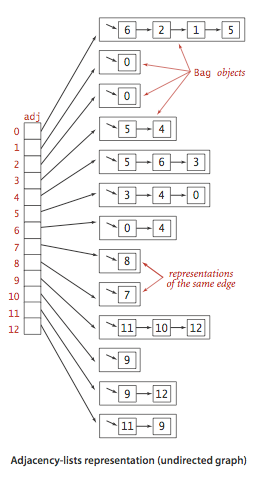DFS和BFSJava實現
阿新 • • 發佈:2017-08-15
() int ces 廣度 第一個 廣度優先 廣度優先搜索 alt java實現
package practice; import java.util.Iterator; import java.util.Stack; import edu.princeton.cs.algs4.*; public class TestMain { public static void main(String[] args) { Graph a = new Graph(6); a.addEdge(2, 4); a.addEdge(2, 3); a.addEdge(1, 2); a.addEdge(0, 5); a.addEdge(0, 1); a.addEdge(0, 2); a.addEdge(3, 4); a.addEdge(3, 5); System.out.println(a); DisposeMap df = new DisposeMap(a); /*df.dfs(0); System.out.println(df.hasPathTo(1)); System.out.println(df.hasPathTo(2)); Stack<Integer> aStack = df.pathTo(1); while (!aStack.isEmpty()) { System.out.print(aStack.pop() + "->"); } System.out.println("end");*/ df.bfs(0); for (int i = 0; i < 6; i++) { System.out.println(df.marked(i)); } Stack<Integer> aStack = df.pathTo(4); while (!aStack.isEmpty()) { System.out.print(aStack.pop() + "->"); } System.out.println("end"); } } /* * 圖處理dispose */ class DisposeMap { private boolean[] marked; private int count = 0; private Graph G; private int s; //起點 private int[] edgeTo; //edgeTo[w] = v,w為圖中的節點,v為它的父節點 public DisposeMap(Graph G) { this.G = G; marked = new boolean[G.V]; edgeTo = new int[G.V]; for (int i = 0; i < marked.length; i++) { marked[i] = false; } } /* * 深度優先搜索,儲存以s為起點所能到達的所有點 */ public void dfs(int s) { marked[s] = true; count++; System.out.println("Search" + s); for (Integer b : G.adj(s)) { //搜索一個節點的相鄰的第一個沒有被標記過的節點 if (marked[b] == false) { edgeTo[b] = s; dfs(b); } } } /* * 廣度優先搜索 */ public void bfs(int s) { edu.princeton.cs.algs4.Queue<Integer> queue = new Queue<Integer>(); queue.enqueue(s); marked[s] = true; while (!queue.isEmpty()) { Integer temp = queue.dequeue(); for (Integer b : G.adj(temp)) { //搜索一個節點的所有的相鄰的節點 if (marked[b] == false) { queue.enqueue(b); edgeTo[b] = temp; marked[b] = true; } } } } /* * 查看某點是否被標記 */ public boolean marked(int w) { return marked[w];} /* * 搜索了幾個點 */ public int count() { return count;} /* * 是否存在s到v的路徑 */ public boolean hasPathTo(int v) { return marked(v); } /* * s到v的路徑,有則返回一個Stack,沒有則返回null */ public Stack<Integer> pathTo(int v) { Stack<Integer> a = new Stack<Integer>(); for (int i = v; i != s; i = edgeTo[i]) a.push(i); a.push(s); return a; } } /* * 圖 */ class Graph { Bag<Integer>[] graph; //這裏使用背包的數組,鄰借表 int V; int E; public Graph(int V) { this.V = V; graph = (Bag<Integer>[]) new Bag[V]; for (int i = 0; i < graph.length; i++) { graph[i] = (Bag<Integer>) new Bag(); } } /* * 返回頂點數 */ public int V() { return V;} /* * 返回邊數 */ public int E() { return E;} /* * 向圖中添加一條邊 */ public void addEdge(int v, int w) { graph[v].add(w); graph[w].add(v); E++; } /* * 和v相鄰的所有頂點 */ public Iterable<Integer> adj(int v) { return graph[v]; } /* * 計算v的度數 */ public static int degree(Graph G, int v) { int degree = 0; for (Integer bag : G.graph[v]) degree++; return degree; } @Override public String toString() { String s = V + " vertices, " + E + " edges\n"; for (int v = 0; v < V; v++) { s += v + ": "; for (Integer integer : this.adj(v)) { s += integer + " "; } s += "\n"; } return s; } } /* * 背包 */ class Bag<T> implements Iterable<T> { Node first; private class Node { T value; Node next; } public void add(T value) { Node oldfirst = first; first = new Node(); first.value = value; first.next = oldfirst; } public void delete(T value) { } @Override public Iterator<T> iterator() { return new BagIterator(); } private class BagIterator implements Iterator<T> { Node node = first; @Override public boolean hasNext() { return node != null; } @Override public T next() { T tempt = node.value; node = node.next; return tempt; } } }
鄰接表示意圖

DFS和BFSJava實現
